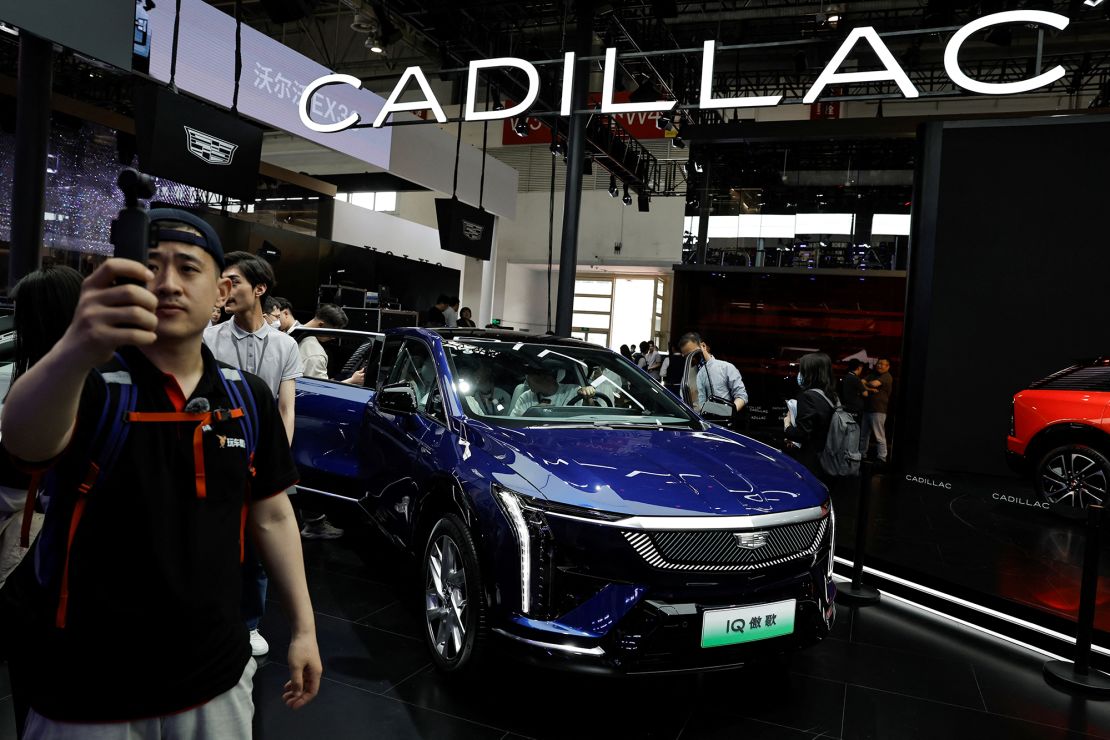Physical Address
304 North Cardinal St.
Dorchester Center, MA 02124
Physical Address
304 North Cardinal St.
Dorchester Center, MA 02124

New York
CNN
—
It wasn’t long ago that China was General Motors’ biggest and most profitable market. While the company was hemorrhaging money in North America and Europe, and facing bankruptcy and bailouts, sales and profits in China kept it afloat. lights on
Now it’s the other way around. GM is making record profits at home, but it’s losing enough money in China that there are questions about how much longer it can hang around. At the same time, Chinese automakers have flooded their home market with the desirable kind Electric vehicles wanted by Chinese buyers and once rejected by American automakers.
The result has been a disaster for China’s foreign automakers.
GM’s China sales fell 19% in the first nine months of the year, and it lost $347 million in Chinese joint ventures over the same period. He made his announcement at the beginning of the month net income would be reduced by more than $5 billion Because of the Chinese problems.
About half of that reflects the cost of restructuring and possibly downsizing its operations there. The other half is a reflection that the value of the Chinese operations was not justified by today’s economic reality.
“You can look back 15, 20 years when GM’s China operations were its lifesaver. Certainly not now. It’s a money pit,” said Jeff Schuster, global vice president of automotive research at research firm GlobalData. “All international brands are suffering in China.”
While GM has not disclosed details of its restructuring in China, Schuster and other experts said most Western automakers, including GM, are considering how long they can stay in the world’s largest auto market.
GM CEO Mary Barra told investors in October that Western automakers face a “very difficult environment” in China, but that GM is confident they can turn things around and stay in the country. Others are not so sure.
“There were golden years for GM in China, but those are over, and they will never have a comeback story,” said Michael Dunne, an auto industry consultant who has been involved in efforts by Western automakers in China since the 1990s, among others. Entering the GM market.
And it’s not just GM that’s in trouble in China. Most western automakers that rushed to build and sell vehicles in the country in the late 1990s and early 2000s are now struggling.
Chinese consumers who once preferred Western brands now find Chinese brands to be better value. This new preference is driven in large part by Chinese government policies and incentives to encourage the shift from traditional gasoline-powered cars to electric vehicles and plug-in hybrids.
“If you’re a seller of mass maker brands, you’re very vulnerable in China,” Dunn said. “Most (Western automakers) will be forced out of the market in the next five years, if not sooner.”

Chinese automakers sell about 70 percent of cars in the country, according to data from the China Passenger Car Association. As of five years ago, they only had 38% of the Chinese market, while foreign brands were catching up the rest
When GM entered the country, China essentially required Western automakers to partner with Chinese manufacturers who would have at least a 50% stake in the joint venture. But Dunne said he sees little chance of GM extending its joint venture with SAIC, which expires in 2027, or other smaller Chinese automakers. And most other Western automakers are also seeing their efforts stymied.
Stellantis – the European automaker that makes cars under the Jeep, Ram, Dodge and Chrysler brands in North America – saw its joint venture Jeeps in China file for bankruptcy in 2022 after years of losses. Ford says it is still profitable in China, but most of the money from Chinese joint ventures comes from exports to other Asian markets and even South America.
GM has pulled out of a big market before. The automaker completely left the European market in 2017, having dropped its Chevrolet brand three years earlier.
It is the biggest problem China has shifted in recent years from traditional gasoline-powered cars to electric vehicles or plug-in hybrids, which now make up the majority of its market. The country implemented policies and incentives that pushed buyers toward electric vehicles, where they found better cars and values from Chinese brands.
“Ten years ago, President Xi Jinping and China’s automakers decided, “We’ve been chasing the world’s automakers in internal combustion engine vehicles, and we’re not succeeding. We’re going the whole hog on electricity,’” Dunn said.
Western automakers tried to stay the course with gasoline-powered cars, and for the most part, so did their JV partners. Now those companies – apart from Tesla, which has a factory in Shanghai – are falling far behind lower-priced electric vehicles and hybrids from Chinese automakers such as BYD.
It was a colossal miscalculation by Western automakers, said Bill Russo, head of Shanghai-based investment advisory firm Automobility and head of Chrysler’s Northeast Asian operations from 2004 to 2008.

“Foreign brands did not prioritize. They didn’t see it coming,” he said.
He said much of the market’s turnaround occurred in 2020 and early 2021. The Covid-19 pandemic has made it difficult for top Western carmakers to travel to China, making it easy to miss the market’s earthquakes. And while Western automakers have announced plans to sell more electric cars, they will sell gasoline-powered vehicles for at least the next 10 years.
And they’re still losing money on EV production, even as Chinese competition gains market share.
“They thought they had the time they didn’t,” Russo said.
Russo said it would be another big mistake for Western automakers to ignore China now that they are not competitive.
Even if the incoming Trump administration rolls back the rules and Incentives for US Electric Vehicle BuyersAmerican automakers other than Tesla will have to comply with tougher emissions rules and restrictions on gasoline-powered cars elsewhere. And in the future they will have to learn to compete with Chinese automakers and their cheap electric cars, he said.
“Losing China would be a disaster for any automotive company,” Russo said. “But never underestimate a corporation’s ability to prioritize short-term profitability over long-term viability.”
CNN’s Hassan Tayir contributed to this report.